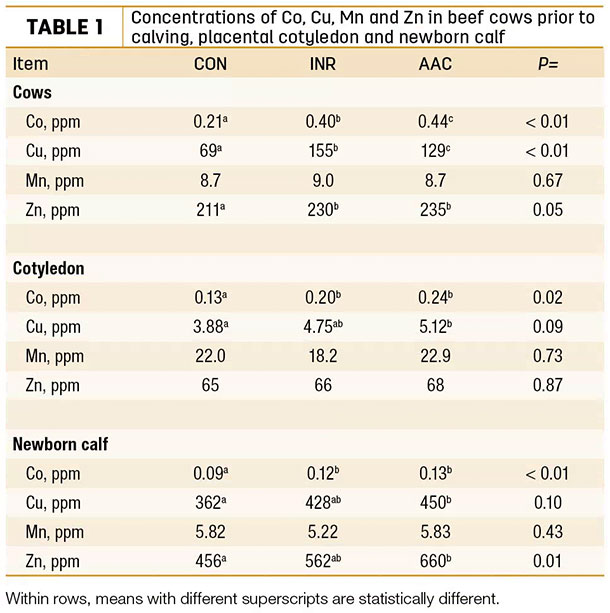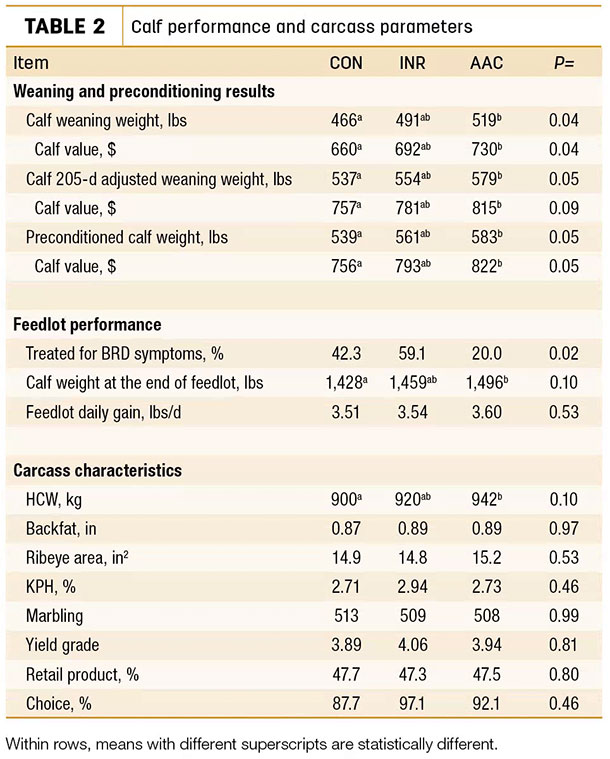Therefore, we theorized that supplementing Cu, Mn, Zn and Co to late-gestating cows could benefit postnatal offspring productivity. In addition, we also theorized that offspring productivity would be further enhanced when an organic source of Cu, Mn, Zn and Co was fed to cows, given that organic sources may have superior biological activity than inorganic sources.
To test our hypotheses, we conducted an experiment at the Eastern Oregon Agricultural Research Center in Burns, Oregon, and compared the effects of organic and inorganic Cu, Mn, Zn and Co supplementation to late-gestating beef cows to determine productive responses of the offspring.
In our experiment, 84 multiparous, non-lactating, pregnant Angus-Hereford cows were assigned to a forage-based diet containing: 1) sulfate sources of Cu, Co, Mn and Zn (INR), 2) organic-complexed sources of Cu, Mn, Co and Zn (AAC; Availa 4), and 3) no Cu, Co, Mn and Zn supplementation (CON).
From day zero until calving, cows were offered diets formulated to meet their requirements for energy, protein, minerals and vitamins.
The INR and AAC diets were formulated to provide the same daily amount of Cu, Co, Mn and Zn based on 7 grams per cow daily of organic-complexed trace mineral (metal-to-amino acid complex ratio of 1-to-1 for Zn, Cu and Mn, in addition to Co glucoheptonate).
After calving, cow-calf pairs were managed as a single group with inorganic trace mineral supplementation. Calves were weaned at 6 months old and preconditioned on pasture as a single group for 45 days, with free-choice access to an inorganic mineral supplement.
After preconditioning, calves were transferred to a commercial feedlot where they were managed as a single group until slaughter at a commercial packing facility.
Results
All diets were formulated to provide adequate amounts of nutrients and trace minerals, based on the requirements of pregnant cows during last trimester of gestation. Inclusion of the inorganic or organic Cu, Co, Mn and Zn sources equally increased concentration of these trace elements in INR and AAC diets.
Therefore, results from this experiment should not be associated with trace mineral deficiency in CON diet, but with potential fetal programming effects of additional Cu, Co, Mn and Zn intake by AAC and INR cows.
Prior to calving, liver concentrations of Co, Cu and Zn were increased in INR and AAC compared with CON cows, whereas INR had reduced liver Co but greater liver Cu compared with AAC cows (Table 1), suggesting that both INR and AAC diets successfully increased liver content of Co, Cu, Zn, but not Mn.

After calving, we also collected liver samples from the newborn calf, as well as samples from the placenta for trace mineral analysis (Table 1). In cotyledons (the calf portion of the “placental buttons”), Co concentrations were greater in AAC and INR compared with CON cows, and Cu concentrations were only increased in AAC compared with CON cows.
Calves from INR and AAC cows had greater liver Co concentrations compared with calves from CON cows, but liver Cu and Zn concentrations were only increased in calves from AAC cows compared with cohorts from CON cows.
Hence, supplementing inorganic and organic Co, Cu, Mn and Zn sources to beef cows during late gestation increased the concentration of Co in the placenta and newborn calf liver, indicating increased passage of this trace mineral through the placenta to the fetus.
Similar outcomes were detected for calf liver Cu and Zn only when comparing AAC and CON cows, suggesting enhanced transfer of these elements from maternal to fetal tissues when the organic source was offered.
Weaning bodyweight (actual or 205-day adjusted) were greater for calves from AAC cows compared with calves from CON cows, and similar between calves from INR cows compared with the other treatments (Table 2).

At the end of the 45-day preconditioning, bodyweight was still greater for calves from AAC cows compared with calves from CON cows, and similar between calves from INR cows compared with the other treatments (Table 2). Hence, supplementing pregnant beef cows during late gestation with Co, Cu, Zn and Mn increased weaned calf weight by more than 40 pounds when the AAC diet was fed.
During the initial month in the commercial feedlot, when bovine respiratory disease (BRD) incidence is elevated in feeder cattle, the proportion of calves treated for BRD symptoms was reduced in calves from AAC cows compared with calves from INR and CON cohorts (Table 2).
During gestation, Zn, Cu, Mn and Co are also essential for development of the fetal immune system, suggesting that feeding the AAC diet to late-gestating cows also resulted in programming effects on postnatal offspring health. No statistical treatment differences were detected for calf mortality and average daily gain in the feedlot (Table 2).
Final calf bodyweight and hot carcass weight upon slaughter were still greater for calves from AAC cows compared with calves from CON cows, and similar among calves from INR cows compared with AAC and CON cohorts. No statistical treatment differences were detected for any of the other carcass merit traits evaluated (Table 2).
Collectively, these outcomes suggest that treatment effects on final and hot carcass weight were resultant from the greater weaning weight in calves from AAC cows compared with CON cohorts, while treatments and differences in final weight failed to impact carcass merit traits.
Implications
Collectively, outcomes from this experiment are suggestive of programming effects on postnatal offspring growth and health resultant from the AAC treatment.
Hence, supplementing late-gestating beef cows with an organic Co, Cu, Zn and Mn appears to be an alternative to optimize offspring productivity in beef production systems. ![]()

-
Reinaldo F. Cooke
- Beef Cattle Specialist
- EOARC – Burns Station
- Oregon State University
- Email Reinaldo F. Cooke







